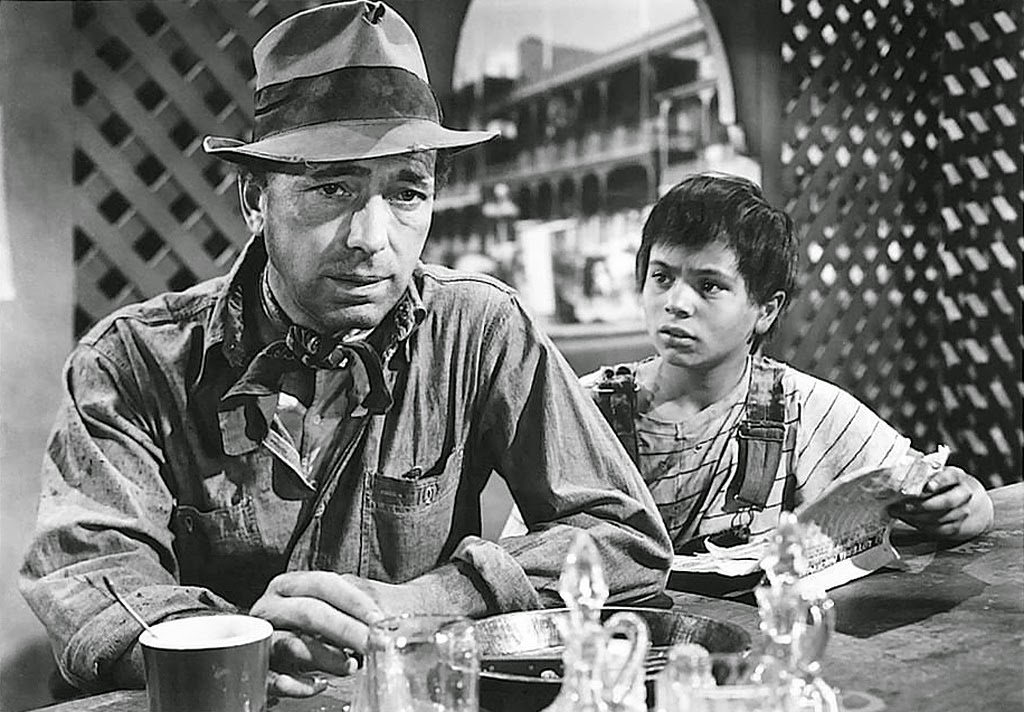John Huston, 1948
Starring: Walter Huston, Humphrey Bogart, Tim Holt, Bruce Bennett
Two down on their luck men – Dobbs and Curtin – experience a number of
setbacks, including being cheated out of money, meet an aged gold prospector,
Howard. They travel through Mexico into the Sierra Madre mountains to look for
gold and hopefully strike it rich. Though they do find gold in a mine, they
must contend with bandits, a mine collapse, a wind storm, and much more. To
make matters worse, none of the men trust each other, particularly not Dobbs,
who becomes paranoid and begins slipping towards madness when a fourth man – an
American named Cody – appears. Will they kill him? Or will they be killed by
bandits – or the mountains themselves – first?
Written by director John Huston, the script is
based on B. Traver’s novel of the same. This tale of obsessive greed came at a
startlingly odd time – most of the men involved in the film – Bogart and Huston, in
particular – were forced to testify at the HUAC hearings against suspected
communists. Though Bogart was outspoken against these hearings, he eventually
had to make a public statement that he was against communism and remain neutral
throughout the trial, which wound up ruining the lives of ten other Hollywood
men. It’s especially odd that The
Treasure of Sierra Madre, a scathing indictment of capitalism, made it past
the censors (all but a scene of Bogart’s decapitated head rolling through the
mountains) and become one of the most influential and beloved films of all
time.
Many of Huston’s
films showed the debilitating effects of greed, including his first with
Bogart, The Maltese Falcon (1941). In
both films the object of value – the bejeweled falcon statue and the bags of
gold – act as a MacGuffin for the real themes of murder, greed, and moral
bankruptcy. Where I believe Treasure of
the Sierra Madre has some crossovers with film noir is in its unspoken
statement about the American dream. This is an outright implication of the
failure and inherent corruption within the American dream itself – a literal
search for gold through the America that ends in insanity and death. The
“happy” ending involves prosaically abandoning treasure (and the search for it)
in order to live in a village full of Mexican natives, where things are shared
between the large, family-style tribe.
The noir-like themes of greed,
desperation, and the ugliness of humanity are apparent in nearly every frame
and not a single shot is wasted in perhaps Huston’s greatest and most
economical of films. Outside of the partnership of Cody and Howard, everyone
character has a “each man for himself” mentality and is out to get everyone
else. This nihilism underscored by nature itself, as everything that could go
wrong does. Where Howard is able to take this all in stride – ending the film
regressing through civilization to a tribal lifestyle – it drives Dobbs mad. The
gold, somewhat jarringly, is no one’s reward and the wind carries it back into
the sand.
This
mixture of noir, western, and adventure film does have some humor in it to balance out the
despair and nihilism. Tragedy and irony work against each other to carry
forward one of the most straightforward and yet unusual films of the period.
Everything is perfect or near perfect, including the dazzlingly filthy
cinematography from Ted McCord. This was one of the first Hollywood films shot
outside the country and most of it was actually shot in Mexico.
The performances are some of the finest in the ‘40s. Bogart is at his most
unpleasant and memorable here as Dobbs, first when he betrays his comrades and
later when he gives into to paranoia and insanity. While he is often criticized
as just showing up on set and being Bogart, rather than acting, this is surely
the film to prove his detractors are wrong. Excellent as Bogie may be, director
John Huston’s father, Walter Huston, absolutely steals the film as the tough
but kindly Howard. Huston wrote the part for his father and the older man is
brilliant in it. His character is whimsical, witty, and almost Buddha-like in
his search for something more than the proscribed American trio of financial
success, stability, and family. Bruce Bennett (Dark Passage, the Tarzan films)
is also memorable as the newest member of the group, Cody, whose presence moves
the film towards its bloody conclusion. Robert Blake (The Little Rascals) and John Huston both have memorable side roles
and overall, every performance is excellent.
I can’t say enough good
things about Treasure of the Sierra Madre
and it is certainly a must-see in the annals of classic America cinema. I still
can’t quite wrap my brain around the fact that Huston was able to make this
film during the almost bloodthirsty anti-Communism running rampant in American
during this period, which gives it a further note of delicious irony. Pick up
the two-disc
special edition, which comes with a number of great special featurees.


No comments:
Post a Comment